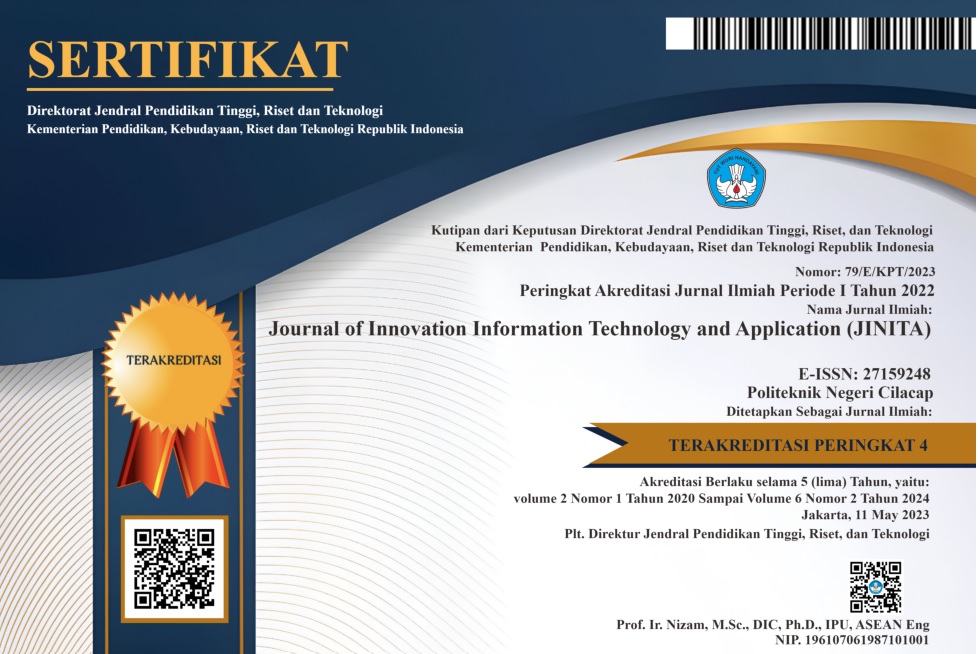Penerapan Metode Simpleks pada Usaha Dagang Bintang Tiurma
 Abstract views: 254
,
Abstract views: 254
,
 PDF (Bahasa Indonesia) downloads: 135
PDF (Bahasa Indonesia) downloads: 135
Abstract
Bintang Tiruma Trade Business is a Trading Business (TB) that is engaged in trade, namely the production of furniture such as minimalist doors and panel doors. Along with business development accompanied by intense competition, many problems arise and also affect TB, one of which is related to the availability of raw materials. Available raw materials have a limited amount that affects the production process. In order to maintain the development of production, it takes several stages in order to allocate raw materials and increase profits. The combination of the simplex method in processing data and the use of POM-QM software for Windows 5.0 for data analysis can be used as a solution in solving this problem. The result is that this method can speed up and simplify the calculation in determining the maximum profit obtained from the sale of minimalist doors and panel doors made within 1 (one) week. In addition, this greatly helps Bintang Tiurma TB to overcome the constraints of the availability of raw materials.
References
R. E. Simamora, A. Loho, and L. Rengkung, “OPTIMALISASI PRODUKSI MEUBEL PADA BALAI LATIHAN PENDIDIKAN TEKNIK (BLPT) KAATEN, KOTA TOMOHON,” Agri-SosioEkonomi, vol. 14, no. 1, pp. 25–34, 2018.
A. Suhara, “Optimasi Pemotongan Bahan Kayu Untuk Produk Meja Di Industri Meubel Cipta Karya Mandiri, Adiarsa Barat - Karawang,” Buana Ilmu, vol. 1, no. 1, pp. 94–113, 2016.
M. S. Rumetna, T. N. Lina, T. Aponno, A. Palisoa, and F. Singgir, “Penerapan Metode Simpleks Dan Software POM- QM Untuk Optimalisasi Hasil Penjualan Pentolan Bakso,” Ilm. Manaj. Inform. dan Komput., vol. 02, no. 03, pp. 143–149, 2018.
M. Rumetna, Supriyanto et al., “PENERAPAN METODE SIMPLEKS UNTUK MENGHASILKAN KEUNTUNGAN MAKSIMUM PADA PENJUAL BUAH PINANG,” J. Dedication To Papua Community2, vol. 2, no. 1, pp. 75–86, 2019.
M. S. Rumetna et al., “Mengoptimalilasi keterbatasan sumber daya untuk memaksimalkan keuntungan penjualan es kelapa muda menggunakan metode simpleks dan software pom-qm,” Pengabdi. Masy., vol. 02, no. 02, pp. 136–149, 2019.
N. Luh and G. Pivin, “Penerapan Metode Simpleks Untuk Optimalisasi Produksi Pada UKM Gerabah,” in Konferensi Nasional Sistem & Informatika, 2017, vol. 3, pp. 208–213.
E. N. Ekwonwune and D. C. Edebatu, “Application of Linear Programming Algorithm in the Optimization of Financial Portfolio of Golden Guinea Breweries Plc, Nigeria,” Open J. Model. Simul., vol. 04, no. 03, pp. 93–101, 2016.
V. Ngamelubun et al., “Optimalisasi Keuntungan Menggunakan Metode Simpleks Pada Produksi Batu Tela,” Ris. Komput., vol. 6, no. 5, pp. 484–491, 2019.
R. Ong et al., “Maksimalisasi Keuntungan Pada Usaha Dagang Martabak Sucipto Menggunakan Metode Simpleks Dan POM-QM,” Ris. Komput., vol. 6, no. 4, pp. 434–441, 2019.
D. K. Nadar, “Some Applications of Simplex Method,” Int. J. Eng. Res. Rev., vol. 24, no. 1, pp. 60–63, 2016.
N. P. & Akpan and I. A. Iwok, “Application of Linear Programming for Optimal Use of Raw Materials in Bakery,” Int. J. Math. Stat. Invent. www.ijmsi.org, vol. 4, no. 8, pp. 51–57, 2016.
Z. Nasution et al., “PENERAPAN METODE SIMPLEKS UNTUK MENGANALISA PERSAMAAN LINIER DALAM MENGHITUNG KEUNTUNGAN MAKSIMUM,” J. Ris. Komput., vol. 3, no. 4, pp. 42–48, 2016.
M. S. Rumetna, T. N. Lina, L. Simarmata, L. Parabang, A. Joseph, and Y. Batfin, “Pemanfaatan POM-QM Untuk Menghitung Keuntungan Maksimum UKM Aneka Cipta Rasa (ACR) Menggunakan Metode Simpleks,” in GEOTIK, 2019, pp. 12–22.
Firmansyah, D. J. Panjaitan, M. Salayan, and A. D. Silalahi, “PENGOPTIMALAN KEUNTUNGAN BADAN USAHA KARYA TANI DI DELI SERDANG DENGAN METODE SIMPLEKS,” J. Islam. Sci. Technol., vol. 3, no. 1, pp. 18–28, 2018.
Copyright (c) 2020 Journal of Innovation Information Technology and Application (JINITA)

This work is licensed under a Creative Commons Attribution 4.0 International License.
Authors who publish with this journal agree to the following terms:
- Authors retain copyright and grant the journal right of first publication with the work simultaneously licensed under a Creative Commons Attribution License that allows others to share the work with an acknowledgement of the work's authorship and initial publication in this journal.
- Authors are able to enter into separate, additional contractual arrangements for the non-exclusive distribution of the journal's published version of the work (e.g., post it to an institutional repository or publish it in a book), with an acknowledgement of its initial publication in this journal.
- Authors are permitted and encouraged to post their work online (e.g., in institutional repositories or on their website) prior to and during the submission process, as it can lead to productive exchanges, as well as earlier and greater citation of published work (See The Effect of Open Access).
















